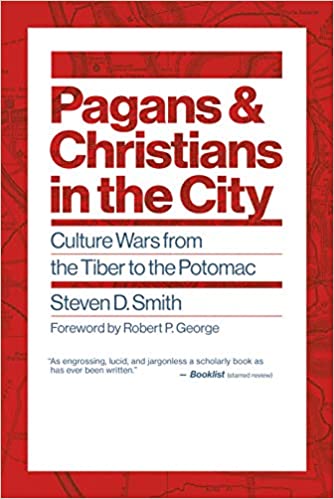The contemporary culture wars tearing at America’s social fabric, Steven Smith argues in Pagans and Christians in the City, are less about conservative and liberal values or Christianity versus secular visions of social order. Rather, they amount to a standoff of competing forms of religiosity hundreds of years in the making. In his book, not only does Smith aim to show how we have arrived in an era where in some jurisdictions Christians are being forced by law to bake cakes or provide employees with access to contraception. He also brings clarity to what actually divides us: mutually exclusive conceptions of what and where the sacred is to be found (108).
 Smith opens his study with the observation that there is an inherent similarity between why the Romans persecuted Christians with such ferocity in the first and second centuries, and why now Christians are being ordered to “bake the cake, bigot!” (xiii). On the surface, it makes little sense that Rome would respond with such savagery towards Christians, who by all accounts served the common good, often at great personal expense. Not only were they model citizens, abiding by laws out of personal conviction, they were often the first to care the poor and disenfranchised, and the last left tending to the sick in times of plague. The answer, according to Smith, is found in competing religious conceptions of the city and what constitutes it. Paganism is the antithesis of Judeo-Christian belief, and a resurgent “modern paganism” with a competing vision of social order drives the conflict today.
Smith opens his study with the observation that there is an inherent similarity between why the Romans persecuted Christians with such ferocity in the first and second centuries, and why now Christians are being ordered to “bake the cake, bigot!” (xiii). On the surface, it makes little sense that Rome would respond with such savagery towards Christians, who by all accounts served the common good, often at great personal expense. Not only were they model citizens, abiding by laws out of personal conviction, they were often the first to care the poor and disenfranchised, and the last left tending to the sick in times of plague. The answer, according to Smith, is found in competing religious conceptions of the city and what constitutes it. Paganism is the antithesis of Judeo-Christian belief, and a resurgent “modern paganism” with a competing vision of social order drives the conflict today.
For ancient Rome, civic identity was closely tied to pagan civic religion, which established a source for moral norms and notions of the good. Paganism, as Smith argues, is not simply belief in many gods, as many think of it today. Rather, paganism is viewing the world in strictly immanent terms. The gods may provide a sense of the sacred, and they are able to elevate or sanctify elements of ordinary human life, but they are still part of this world and exist on this plane of reality. For Rome, life in the city was viewed as the pinnacle gift from the gods to human civilization, and abiding within it as a responsible citizen both professed gratitude to the gods and secured their further favor. Additionally, because the gods, the city, and this life were all intermingled as sacred, ultimate meaning for life could be found very much within this world. For Romans, the city could be well and truly one’s home.
In contrast to paganism, Christianity professed belief in a transcendent God who made the world from nothing and stands outside and above it. Thus, for Christians the source of the sacred was beyond this world, and though God is intimately involved in this creation, Christians needed to look beyond this world for life’s ultimate meaning. Not only did this render Christian civic loyalty in Rome suspect, as Christians were seen to be unable to commit fully to the city and its gods, but it was also seen as threatening pagan Rome’s libertinism and sexual licentiousness.
The terms of peace extended by pagan Rome to the Christians, Smith highlights, amounted to nothing less than a call for Christians renounce their deepest convictions. Christians were expected to inhabit a city pillared on immanent religiosity where worship of the city’s gods and its emperor served as tests of allegiance. Immanent and transcendent religiosity, however, are mutually exclusive views of the world, and so long as one predominates in a society’s civic identity, the other will be excluded from public discourse.
Accordingly, when Christianity became the dominant religiosity of Rome in the fourth and fifth centuries, paganism was eventually driven underground. Yet, Smith says, it was never extinguished. It resurfaced in the Renaissance as an artistic nostalgia over a lost civilization. As Christianity began to lose its hegemony at the dawn of the modern era, paganism reemerged, showing itself to have been reborn albeit in modified form.
Western secularism is nothing short of paganism, Smith argues, not in the sense that it embraces polytheistic belief, but in its claim that that this world and this life is all there is. It is a form of strictly immanent religiosity, where the source for moral norms and the significance to life can only be framed without recourse to belief in God. Unlike classic paganism which viewed the source of the sacred as coming from the gods, modern paganism has turned inward to discover the sacred within the individual, in her reason and most of all in her feelings.
Thus, the conflict between pagan and Christian religiosity continues to divide Western society, and the fight in the twentieth century has been over what constitutes civic identity. For Smith, the strife between ancient Rome and Christians is recapitulated in the contemporary culture wars. In America, two fronts have witnessed the most fighting: constitutional law and sexuality. Regarding the first, courts generally have ruled that the “non-establishment clause” of the Constitution amounts to a mandate against state-sanctioned endorsement of transcendent religiosity. This amounts to an immanent-secularist reframing of American social order.
The second front is evidenced in efforts to displace Christian norms of sex within the confines of marriage and marriage defined as a union between one man and one woman. In their place is the push for a fundamentally pagan sexuality in which sex is seen as natural and boundless, with the only restrictions placed on sexual expression being conventional and on the basis of consent. In effect, sex and individual desire has been elevated to the status of sacred, with Christianity’s moral norms seen as an affront to personal dignity.
Smith ends his study with a look at how tenable the pagan revision of contemporary American social order can be. He argues that because America, like modern Western civilization as a whole, emerged from under a distinctly Christian canopy of belief, the grounds for pluralistic society which we now enjoy are direct products of Christians’ providing a way for people with competing beliefs to live peaceably together. Because Christians see the city as a relative good in which individuals must be free to worship that which is ultimate and beyond the immanent world, pluralism is a contribution unique to Christianity.
Paganism could never have produced such a social order, and therefore to the extent it seeks to preserve it, it is living on borrowed capital. It stands to be seen whether modern paganism can create a city in which we would actually want to live. “In sum,” he says, “modern paganism may yearn for community, but it has been forced to take an adversarial stance toward the actual substance of the community against which it has had to assert itself” (356). To the degree modern paganism succeeds in driving Christianity underground, the culture wars will end in societal devolution.
Smith’s argument is as provocative as it is sweeping in its survey of classical and contemporary culture wars. His claim that modern secularity is nothing less than reimagined paganism for post-Christian sensibilities helps underscore what many social critics have been arguing for a while. Secularism is not the absence of religious belief, but a unique form of belief itself. Further, as Smith highlights, exclusive-immanentist religiosity is not only morally bankrupt, providing no good grounding of moral norms, it is also socially abortive. By locating the source of the sacred, and therefore the ultimate meaning in life, within the individual, modern paganism envisions a society in which each individual is king and a competing authority on what constitutes our civic identity. Further, the contemporary virtue of tolerance is a farce, a self-preening hypocrisy in which the terms for what can be tolerated are limited to only what modern pagans can endorse. Thus, Christians are pushed from the marriage industry, from the arts, and from the university halls in the name of toleration, while the reality of their own intolerance is lost on society’s elite.
One glaring omission, however, restricts the force of Smith’s argument. In the few short years since the publication of Smith’s book, the debate over sexuality has moved well beyond the implications of Obergefell v. Hodges for understanding the nature of marriage. Now we are fighting over the very definition of gender itself. Clearly, this is an implication of pagan sexuality where the individual’s feelings and self-perception form the only source of moral norms. Smith would have been well-served to explore the push to strip biological sex of its normative status. No doubt he would have concluded that the course towards social devolution at the hands of modern paganism is much more advanced and leading to a pivotal moment of decision.
Regardless, Smith’s book is an important and enlightening contribution to the analysis of how we have arrived at this place in the culture wars and what Christians are up against. History certainly repeats itself, but the stakes in the fight often become more severe as time goes on.
Dennis Greeson is associate director of the BibleMesh Institute and a PhD candidate in systematic theology at Southeastern Baptist Theological Seminary. He lives with his wife and two children in Nashville, Tennessee.
